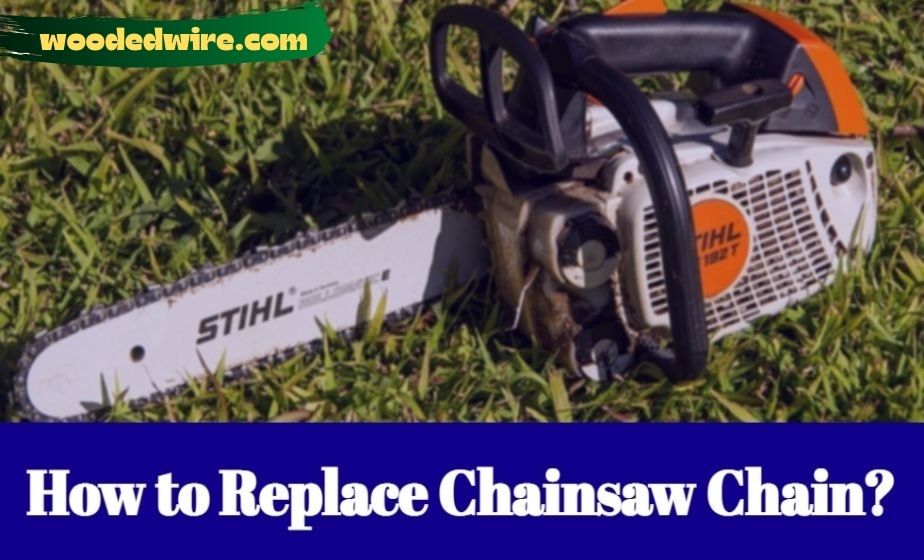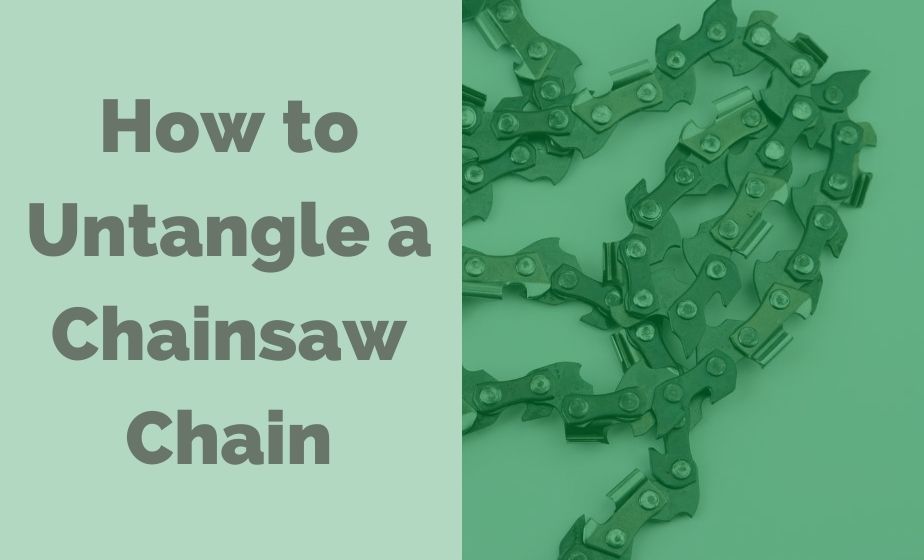When replacing chains, safety is everything. You should know that safety is essential not only for you but for your chainsaw as well. Chains are meant to be replaced every time they run out of gas. If you don’t replace them, they will start to make more noise or even break. So the first step of replacing a chainsaw chain is to ensure you have the right size and type of chain for your saw.
If this is your first time replacing chainsaw chains on your chainsaw, it can be a daunting task to take on. It’s not that difficult to do it yourself on some models, but some can be pretty complicated. This article will show you how to replace chainsaw chains with step-by-step instructions, along with pictures of the process.
How Do I know if I Need A New Chainsaw Chain?
Chainsaws are a handy tool for cutting trees, but you need to make sure they’re in good condition. Chainsaws consist of three main parts: the guide bar, the motor, and the sprocket.
A chain turns distorted and slow when it’s used for a long time. When this happens, the chainsaw becomes less efficient and may even be unsafe. In that case, you need to replace the chain.
Chainsaw usually works at 10,000 and 14,000 RPMs. That means that if you’re not careful, you might get hurt. One of the most common injuries is kickback, which is the number one injury related to chainsaw operation.
It can be challenging to get a straight cut when using a chainsaw. That is most likely because one side of the saw is pulling in one direction, and the other opposite requires the same process.
There is usually a problem with either the teeth on one side of the saw or uneven tooth length. The teeth have also touched rocks or dirt, preventing them from cutting correctly. When you notice that the tops of the saw’s teeth are missing and become dull, you will need to replace your chain.
An Essential Consider When You Replacing Your Chainsaw Chain
When you need to change the chain on your chainsaw, there are a few things you’ll want to keep in mind. First, to measure the height of the guide bar, measure from one end’s tip to the other’s. That will help you determine the length of the chain needed.
Then, measure the ground and scale of the chainsaw. That can be done by eyeing the bar sincerely. Most chainsaw bars have detailed pitch measurements, but you can also check your guidebook or measure them by hand.
7 Best Way to Replace Your Chainsaw Chain
If you’ve got a chainsaw chain that needs replacing, you can learn how below. Of course, it depends on what brand of saw you have, but there are some general steps for this process.
If you require a replacement chain for your chainsaw, you’ll require these tools:
- A flathead screwdriver
- A socket wrench
- A new chain for your chainsaw
Detach your Previous Chainsaw Chain
Your chainsaw has a chain and bar that is attached to the machine. You should detach the side plate of your miter saw so that you can safely access the nuts holding the chain and bar. Generally, you will need to use a wrench to remove two or more nuts for this purpose.
Safety Note:
If you’re removing the side platter, unlock that brake first. Otherwise, it’s going to be tough to put it back on.
Release Your Chainsaw’s Tension
The old chain is ready to be removed now that the sprocket plate is off of the saw. First, you’ll need to do the following steps. Now, take the chain’s tensioner and pull the bar’s nose away from it. Next, release the chain by loosening the screw on the side closest to you. Once you’ve done that, take the chain in your hand and pull it off until it falls to the ground.
Loosening Your Tension Screw
There is a tensioning screw that you will find inside the guide bar. The screw should be loosened before adding a new chain, or it can be challenging to install. You should take the time to loosen the screw so installing the replacement chain will be up to scratch. If you skip this step, you will find it challenging to put on a new blade.
Threading Your Chain onto the Saw
You can let the drive links come into contact with your clutch drum by pulling the nose of the bar away from the chainsaw. Make sure that the bar is lined up with the tension of your saw by applying some pressure to it.
It’s simple to thread your chainsaw. First, you need to take it out of the box. Next, place the chain on the clutch drum and the guide bar. Next, make sure that the chain is being pulled taut by tightening it with your hand. Finally, put the guide bar onto the saw’s adjustment pin while holding it taut.
Replace the Side Plate
Tightening a chain is a lot easier with a socket wrench and a hammer. Put the bars guide on the ground, and then place the chainsaw’s side plate onto it. Then take off the old nuts with the wrench and put on the new ones. You’ll want to tighten them up bit by bit until you’re done.
Tighten the Chain to the Correct Tension
If your chainsaw is pulling to the left or right, you may need to adjust the tension on the chain. To do so, look at the tensioning screw to the side of the guide bar. Then, adjust the tension by turning it with your hand.
Tighten the Others Parts
Complete this final step of the chainsaw chain replacement by finishing tightening the nuts on the side plate. For more information on proper tension, see our article on How to Tighten a Chainsaw Chain.
Note:
The new chain must be the same length or shorter than your old chain when replacing a chain. You should also know that not all chains will fit all bars. Chains must be the right size to work safely.
Most Common Questions About Your Chainsaw Chains Replacement:
Is It Easy to Replace a Chainsaw Chain?
If you use a chainsaw for long periods, you’re probably going to notice that your chainsaw chain is chipped and needs to be replaced. Whether you need a replacement because the last one broke or if it was because you didn’t sharpen it properly, you’ll need to know how to change a chainsaw chain.
Installing a chain properly can seem simple, but you should be aware of several things to make sure the process goes smoothly. First, keep in mind that there are two types of replacement chains: master and non-master links. It’s essential to make sure that you are installing the correct type.
How Loose Should Chainsaw Chains Be?
When you hold a chainsaw, you want to make sure that it’s not too tight or too loose. That will affect the ease with which you can turn the saw to cut the wood. Make sure to set it, so there is a little give. In this way, the blade will be tight enough to cut the wood and allow you to move it quickly. By adjusting the chain’s tightness and looseness, you can prevent it from binding and protect your saw.
Should I Soak My Chainsaw Chain?
Chains and saws go together like peanut butter and jelly. You can’t replace a chain without first breaking it in with bar and chain oil for a few hours. Next, lubricate the pivot points of the saw as well as those on the chain. Keep your saw running while tightening the chain, and make sure it’s tight.
Final Words:
Dull chains are dangerous, but you don’t have to replace them immediately. It’s still important to know how to sharpen your chainsaw chain before it gets too worn for safety. Chain replacement is inevitable, but fortunately, the guide above is straightforward. We recommend wearing gloves when handling the chain because sharp teeth can be dangerous.
Chainsaws are heavy, powerful, and dangerous. However, if you learn to use them correctly and maintain them regularly, they can be a handy tool for trimming branches, cutting firewood, and clearing out brush. A sharp chainsaw chain is an essential part of a well-working chainsaw and is easy to replace once you know the basics. It’s essential to check the manual for your chainsaw to know what size and type of chainsaw chain you need.



